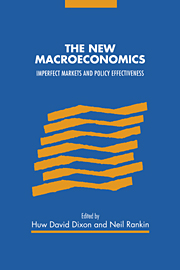Book contents
- Frontmatter
- Contents
- List of contributors
- Preface
- Acknowledgements
- Introduction
- Part I Overviews and perspectives
- Part II Goods market imperfections
- Part III Labour market imperfections
- Part IV Financial market imperfections
- Part V Nominal rigidities and bounded rationality
- 13 Hedging, multiple equilibria and nominal contracts
- 14 Information acquisition and nominal price adjustment
- 15 Expectation calculation, hyperinflation and currency collapse
- 16 Menu costs and aggregate price dynamics
- Bibliography
- Index of authors
- Index of subjects
13 - Hedging, multiple equilibria and nominal contracts
Published online by Cambridge University Press: 13 October 2009
- Frontmatter
- Contents
- List of contributors
- Preface
- Acknowledgements
- Introduction
- Part I Overviews and perspectives
- Part II Goods market imperfections
- Part III Labour market imperfections
- Part IV Financial market imperfections
- Part V Nominal rigidities and bounded rationality
- 13 Hedging, multiple equilibria and nominal contracts
- 14 Information acquisition and nominal price adjustment
- 15 Expectation calculation, hyperinflation and currency collapse
- 16 Menu costs and aggregate price dynamics
- Bibliography
- Index of authors
- Index of subjects
Summary
Introduction
Not all transactions take place in spot markets. Contracts are often written to determine the terms of future trades. Understanding the nature of contracts is therefore an important step in the analysis of the allocation of resources. A robust observation is that most contracts are not indexed to the relevant price level despite the fact that prices at the time of transaction are uncertain and that the parties involved are risk-averse. This constitutes an important puzzle. A risk-averse agent would by definition benefit from a reduction in risk. It would thus seem to be the case that two risk-averse agents would always prefer to turn a nominal contract they have signed into a real one in order to reduce the risk they are bearing. The fact that apparently risk-averse agents write nominal contracts when the aggregate price level is unpredictable therefore constitutes an important puzzle.
A number of explanations have been offered to account for the presence of nominal contracts. Gray (1976), Fischer (1977), Cooper (1988a) show how in the presence of both supply and demand shocks the optimal degree of indexation is less than full, and therefore how some degree of nominal rigidity can arise as an equilibrium phenomenon. However, this approach does not in itself explain why the majority of observed contracts are purely nominal (for instance Card, 1983, reports that about 50 per cent of US wage contracts are not indexed at all, and the same applies with greater force to European contracts).
- Type
- Chapter
- Information
- The New MacroeconomicsImperfect Markets and Policy Effectiveness, pp. 275 - 292Publisher: Cambridge University PressPrint publication year: 1995



